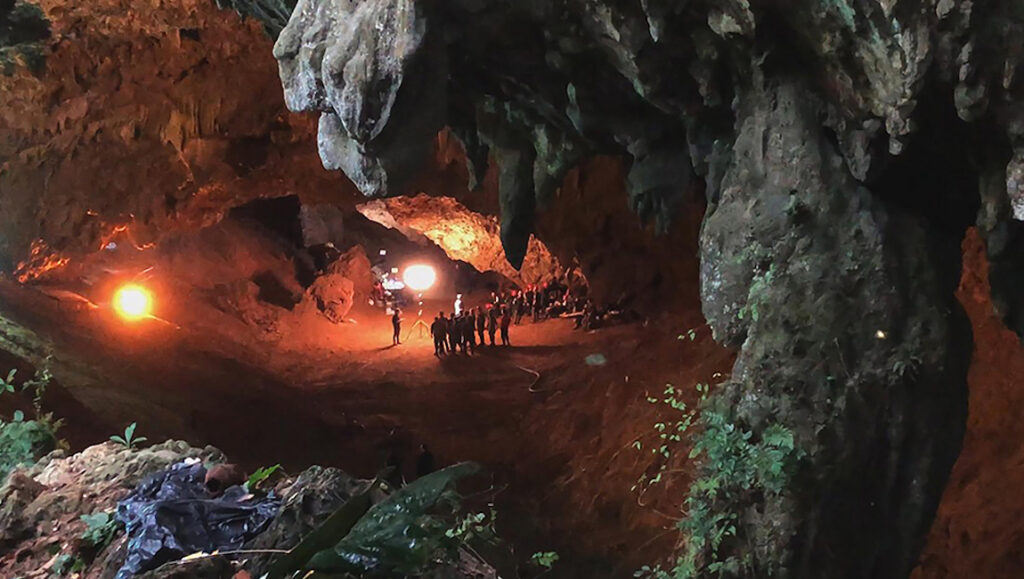The Rescue is a moving work a immersion and stitch-work, crafting an empathetic documentary from its headline-grabbing story.
Elizabeth Chai Vasarhelyi and Jimmy Chin have a knack for humanizing the most extreme situations and conditions on Earth. 2015’s Meru documented Chin’s attempt to climb the eponymous Himalayan peak, while the Oscar-winning Free Solo documented their friend Alex Honnold as he prepared to scale the face of Yosemite’s El Capitan summit without any ropes or safety mechanisms. The married couple’s latest film, The Rescue, centers on yet another harrowing environment: a 10km-long cave system in Northern Thailand known as Tham Luang Nang Non, which encompasses 3 passages and two underwater rivers in a porous limestone mountain that rapidly accumulates water. In June 2018, 12 teenage boys and their 25-year old coach from the local Wild Boar soccer team were exploring the cave when they became trapped by a freak monsoon that quickly left their only means of escape fully submerged.
The Thai Royal Navy immediately sprang into action, assembling a large team of international players and growing flanks of volunteers. But their lack of cave-diving experience proved a major liability, and it soon became clear that the entire rescue operation hinged on an unlikely group of heroes: a handful of unassuming, mostly middle-aged, mostly British amateur cave divers. The film focuses on two such men, retired firefighter Rick Stanton and IT consultant John Volanthen, whose combined expertise and skill distinguish them from the entire Thai Navy. This is no surprise given the relative obscurity of their hobby, which tends to attract socially awkward loners and other “peculiar” types. It turns out that even paratroopers and navy SEALS would rather not hang out in cramped, pitch-black underwater moonscapes.
Unlike in their previous films, Vasarhelyi and Chin weren’t actually present during this weeks-long ordeal. Instead, they stitched the film together by culling over 87 hours of footage taken by the Thai Navy SEALS at the time, much of it never previously released. The highlight is by far the video of the British divers first coming across the missing boys, who were discovered over two hours from the cave’s entrance. In a film stuffed with heartwarming footage, this video is unforgettable; the boys are skinny but in good spirits, and their coach had the presence of mind to teach them meditation and breathing exercises to help them stay calm. Vasarhelyi and Chin supplement such footage with interviews of various key players, including each of the divers who participated in the rescue. In order to accurately convey the cave’s unyielding rock, muddy waters, and near-negative visibility – a claustrophobe’s worst nightmare – the filmmakers rely on hyper-realistic recreations with the divers themselves, filmed in a water tank during the pandemic. The resulting footage gives a sense of how disorienting the conditions must have been, especially with the twin timebombs of dwindling oxygen and another impending monsoon adding to the pressure.
Despite their lack of access, Vasarhelyi and Chin do a fantastic job immersing the viewers in the heated, humid, and high-stakes environment — both in the cave and on the rain-lashed surface — as various branches of the rescue operation debate on how best to extract the boys. There’s not enough time to teach each of them how to dive through the extremely complex cave system on their own, but, on the other hand, waiting for the waters to recede could take months. In the end, an Australian doctor and diver named Richard Harris agreed to a “truth is stranger than fiction” solution that’s shockingly risky — and laughably simple. Amidst this nail-biting tension, the filmmakers also make a point to explore the local folklore surrounding the mountain, contextualizing the round-the-clock prayers that serve as a backdrop to the rescue operation’s military precision. Using beautiful animation inspired by a Buddhist thangka painting, they describe the legend of a mythical princess whose hair is said to form one of the cave’s underground rivers, and then connect this story to the boys in the cave who each receive a bracelet blessed by a revered monk believed to have descended from the princess. It’s a thoughtful touch for a story that’s often dominated by foreign perspectives (Vasarhelyi has said that she and Chin were unable to secure interview rights with any of the survivors.)
Much of the film’s third act is a montage of international news coverage that crescendos towards a peak of ecstatic joy and relief when the Wild Boars are safely extracted from the cave. It’s a hard-won victory that Vasarhelyi and Chin frame as a unified global effort, which makes the story all the more affecting; as a newscaster says, visibly holding back tears, “you’d have to have a heart of stone not to be moved.” It’s all too easy to contrast this story of unbelievable courage and determination with the tribalism and spiteful individualism that’s plaguing the world today, and wonder where we all went wrong. Vasarhelyi and Chin don’t belabor the point, but they don’t have to: viewers will undoubtedly come to the same conclusion. But this shouldn’t detract from the film’s emotional heft, which is handled with grace and care by the filmmakers and producers. No matter how things play out in 2021 and beyond, the image of the boys’ relieved and hopeful faces when they realize they’ve been found stands as a beacon for our boundless capacity for empathy, when we decide that it matters.


Comments are closed.